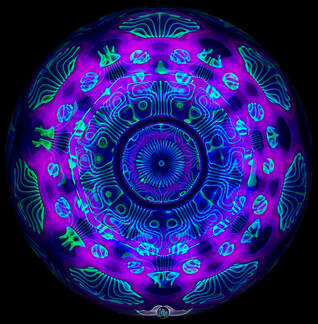On Viscosity and Surface Tension Viscosity is defined to be the property of resistance to flow in any material with fluid properties. Thus, fluids with higher viscosity have a higher resistance to flow and are said to be more viscous than other fluids with lower viscosities. Experimenting with cymatics is a careful dance of viscosity, in one limited aspect. A fluid that is too viscous will not jostle enough to cause interference with itself to create the beautiful standing wave geometries we love in liquid cymatics. However, on the other hand, a fluid that is not viscous enough will be blown out of the pan and will require incredibly small amplitudes and thus may not allow enough energy to create any disturbance in the fluid. Another aspect that plays a crucial role in creating incredible liquid cymatics geometries is surface tension. Surface tension of a fluid can be thought of as the tendency for a fluid to create a “film”, so to speak, at the boundary layer between the fluid and another surface. Surface tension is also the reason why the surface of water in a cup rises as the water nears the edge of the cup, and is also the reason why you can pour water in a cup to the point of creating a small dome of water at the top (the surface tension is keeping the water from spilling over the edge). Thus, fluids with low surface tension will be quite “sloshy” in cymatics, whereas fluids with too much surface tension will not encounter positive/negative wave interference as the fluid in the pan is oscillated by the speaker below. It is interesting to note that as the frequency rises in a cymatics experiment, so too does the need for higher surface tension and viscosity. Thus, certain fluids are better for displaying cymatics at various frequencies than others. And, isn’t it interesting how, though water is the most common, there are many different kinds of fluids here in the world, each with its own viscosity and surface tension for the purpose it provides. An intriguing synchronicity that occurred with my trial-and-error fluid concoctions is that I finally settled on a fluid that has a viscosity of 3.2cp and a surface tension of 58.5 mN/m. After calculating all of that with some home-made lab equipment, I did some research and found that this fluid I work with has the same viscosity and surface tension as our human blood. Isn’t that wild? The most abundant fluid in our bodies just happens to be the same fluid that generates all of these incredible forms and cymatics imagery we have been showing you for the last eight months or so. For more information about the variables that determine a standing wave geometry in liquid cymatics, read Determinants of Faraday Wave-Patterns in Water Samples Oscillated Vertically at a Range of Frequencies from 50-200 Hz by Rupert and Merlin Sheldrake. Thanks, and happy learning! ~ Casey Attebery
0 Comments
Leave a Reply. |
